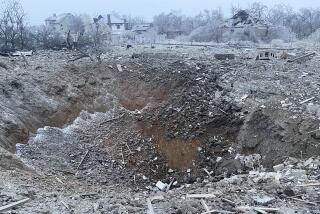Allied Sweep Jars Soviets’ Military Chief : Kremlin: Defense Minister Yazov admits some weak spots, but he cites the older Iraqi weaponry used by Iraqis.
- Share via
MOSCOW — Tactics used by allied forces to pummel Iraq in the Persian Gulf War clearly proved that the Soviet Union’s air defense system “has weak spots,” Defense Minister Dmitri T. Yazov said Thursday.
Top-ranking Soviet military officers, who predicted a long and drawn-out war in the Persian Gulf, seemed to have been caught off guard by the rapid defeat of the Iraqi forces they had helped arm and train.
Answering questions fired at him by national lawmakers, Yazov said the quick success enjoyed by U.S.-led forces in the war points to the need to revamp the Soviet Union’s air defenses.
“What happened in Kuwait and Iraq necessitates a review of the attitude to army air defense and the country’s entire air defense system,” Yazov said. The Soviet military, he said, “is analyzing the use of armed forces by the United States and other countries.”
The Soviet marshal’s assessment during the Supreme Soviet session was the first official acknowledgement that its military has been pushed to reevaluate its strategies based on what it saw during the Gulf conflict.
Yazov was reconfirmed in his post, 275-24, with 53 abstentions, by lawmakers after tough questioning on the current strength of the Soviet military machine.
The Soviet Union had been by far the largest supplier of weapons to Iraq, but it suspended arms supplies after Iraq occupied Kuwait Aug. 2. Yazov fiercely defended the materiel sent to the Iraqis, contending that of the 93 allied aircraft he said had been downed by Iraqi antiaircraft fire (more than double the latest U.S. figures), most had fallen victim to the Soviet-made Shilka system.
However, throughout the conflict, Soviet military experts said the stunning successes enjoyed on the battlefield and in the air by the U.S.-led coalition could not cast doubts on the quality of Soviet arms, since the weapons used by Iraq were far from state-of-the-art.
“Iraq’s weaponry, including that which is Soviet-made, was mainly produced in the 1960s and 1970s and is a generation or two behind the corresponding weaponry of the multinational forces,” Nikolai Kutsenko, deputy director of the Soviet army’s Operational-Strategic Research Center, told the government newspaper Izvestia.
Soviet experts also noted that equipment is only as good as the troops using it and contended that Iraqi soldiers were never up to the level of Soviet servicemen.
More to Read
Sign up for Essential California
The most important California stories and recommendations in your inbox every morning.
You may occasionally receive promotional content from the Los Angeles Times.













